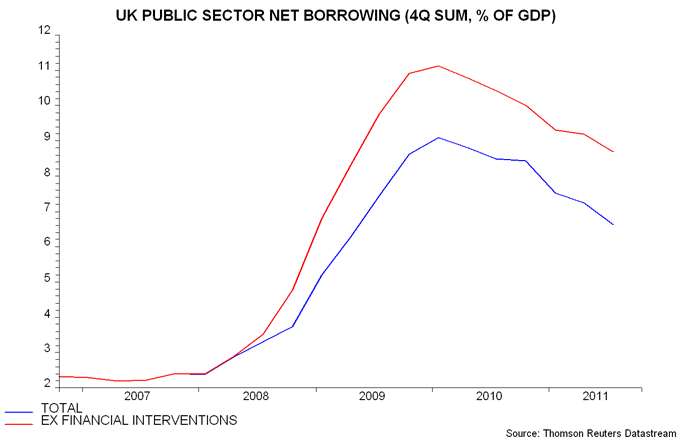UK PSNB suggests scope for slower deficit reduction
The UK’s fiscal position is better than stated by the preferred deficit measure, public sector net borrowing excluding the temporary effects of financial interventions (PSNB ex), suggesting that the government has room to introduce modest stimulus measures without undermining longer-term consolidation plans.
PSNB ex amounted to 8.7% of GDP in the 12 months to September, down from 9.3% in 2010-11 and 11.1% in 2009-10. The recent rate of progress suggests that the OBR’s March forecast of a 7.9% deficit in 2011-12 is still achievable, despite economic weakness.
The position, however, looks much better when financial intervention effects are included. The overall PSNB amounted to 6.6% of GDP in the 12 months to September and could fall to 6% in 2011-12.
In cash terms, the PSNB was £30.8 billion smaller than PSNB ex in the 12 months to September. According to a breakdown provided by the ONS, £17.2 billion of this difference was due to the inclusion of the net surplus of the public sector commercial banks – RBS, Lloyds Banking Group (LBG), Northern Rock and Bradford & Bingley. Income from the Asset Purchase Facility (APF) and Special Liquidity Scheme (SLS) accounted for a further £7.9 billion, leaving a residual £5.5 billion – this “other” category includes the net surplus of the banks’ subsidiaries, suggesting that their consolidated contribution was more than £20 billion.
The PSNB includes the entire surplus of the public sector banks but the government’s economic ownership of RBS and LBG is 83% and 41% respectively. A rough calculation based on the accounts of the individual banks suggests that the consolidated surplus actually due to the government was about £13 billion in the year to September. On this basis, “true” net borrowing was about £109 billion or 7.3% of GDP versus PSNB ex of £129.6 billion or 8.7% of GDP.
The surplus of the public sector banks, of course, is not available to finance government spending. With no dividends being paid, however, the surplus results in a rise in the book value of the government’s shares, an increase that should be reflected in the proceeds of the banks’ eventual sale.
The income from the APF and SLS, by contrast, represents cash that is available to finance PSNB ex, reducing the need for market borrowing. The bulk of the £7.9 billion earned in the year to September was due to the APF, reflecting the spread between the running yield of about 4.5% on the Bank of England’s £200 billion gilt portfolio and the 0.5% it pays on the reserve balances created to finance the purchases. The APF surplus will increase further as a result of “QE2”, assuming no change in Bank rate.
A “true” public sector deficit of 7.3% of GDP in the year to September and about 6.75% in 2011-12 is still much too high. However, if the government aimed to reduce this measure to 2.5% by 2014-15 – equal to the OBR’s March forecast for PSNB ex in that year – the implied rate of deficit reduction over the next three years would be about 0.5 percentage points of GDP per annum slower than under current plans, or about £7 billion pa in cash terms. This would accommodate some fiscal slippage due to economic weakness while creating room for modest tax cuts or investment initiatives to boost growth.


Reader Comments